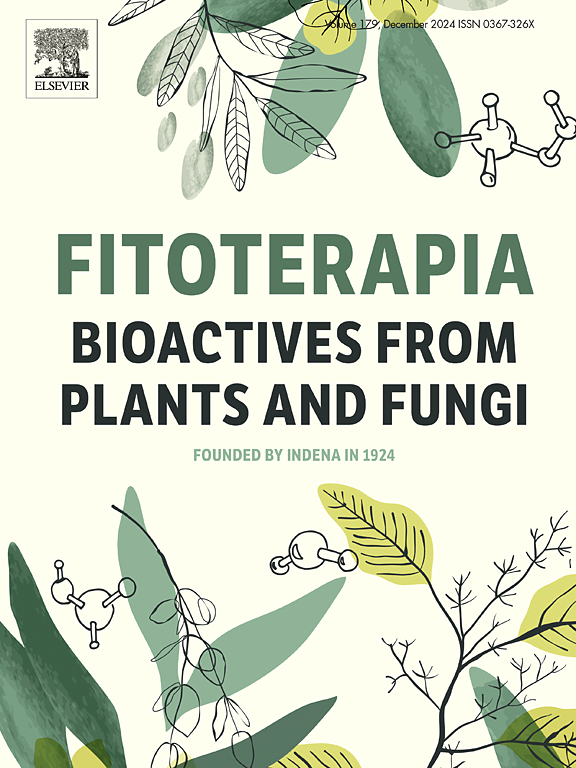Investigation of anti-hepatocellular carcinoma active components and mechanism of Prinsepia utilis seed residue via spectrum-effect relationship integrated with network pharmacology
IF 2.6
3区 医学
Q3 CHEMISTRY, MEDICINAL
引用次数: 0
Abstract
In recent years, the pharmacological activities and potential applications of Prinsepia utilis have garnered significant attention. However, most studies have focused on Prinsepia utilis oil, whereas research on its seed residue remains limited. In this study, the anti-hepatocellular carcinoma activity of Prinsepia utilis seed residue was firstly investigated using an integrated strategy of spectrum-effect relationship analysis and network pharmacology. The chemical fingerprint of Prinsepia utilis seed residue was established via UPLC-Q-TOF-MS. Proliferation inhibition (CCK-8 assay) and migration capacity (scratch assay) were evaluated in HepG2/HSF cells. Ten potential bioactive components including five flavonoid glycosides and five diterpenoid glycosides were identified via spectrum-effect relationship analysis. Network pharmacology revealed 46 anti-tumor and 57 anti-scar hyperplasia targets. Key pathways included cancer, lipid and atherosclerosis, relaxin signaling, and IL-17 signaling. Core targets were prioritized, and molecular docking confirmed favorable binding affinities between bioactive aglycones and these targets. The flavonoid glycosides and diterpenoid glycosides in Prinsepia utilis seed residue exert anti-hepatocellular carcinoma activity primarily by targeting MAPK14, IL-6, STAT3, HRAS, GNAS, CXCL8, and SRC, thus establishing a scientific rationale for their development as potential therapeutic agents.

结合网络药理学的谱效关系研究太子参籽渣抗肝癌活性成分及作用机制
近年来,太子参的药理活性和潜在应用受到了广泛的关注。然而,大部分的研究都集中在太子参油上,而对其种子残留物的研究还很有限。本研究首次采用谱效关系分析和网络药理学相结合的方法研究了太子参籽渣的抗肝癌活性。采用UPLC-Q-TOF-MS建立了太子参种子残留物的化学指纹图谱。检测HepG2/HSF细胞的增殖抑制(CCK-8法)和迁移能力(划痕法)。通过光谱效应关系分析,鉴定出5种黄酮类苷和5种二萜苷等10种潜在生物活性成分。网络药理学发现抗肿瘤靶点46个,抗瘢痕增生靶点57个。关键途径包括癌症、脂质和动脉粥样硬化、松弛素信号和IL-17信号。核心靶点被优先排序,分子对接证实了生物活性苷元与这些靶点之间良好的结合亲和力。黄酮苷和二萜苷主要通过靶向MAPK14、IL-6、STAT3、HRAS、GNAS、CXCL8和SRC发挥抗肝癌活性,从而为其作为潜在治疗剂的开发奠定了科学依据。
本文章由计算机程序翻译,如有差异,请以英文原文为准。
求助全文
约1分钟内获得全文
求助全文
来源期刊

Fitoterapia
医学-药学
CiteScore
5.80
自引率
2.90%
发文量
198
审稿时长
1.5 months
期刊介绍:
Fitoterapia is a Journal dedicated to medicinal plants and to bioactive natural products of plant origin. It publishes original contributions in seven major areas:
1. Characterization of active ingredients of medicinal plants
2. Development of standardization method for bioactive plant extracts and natural products
3. Identification of bioactivity in plant extracts
4. Identification of targets and mechanism of activity of plant extracts
5. Production and genomic characterization of medicinal plants biomass
6. Chemistry and biochemistry of bioactive natural products of plant origin
7. Critical reviews of the historical, clinical and legal status of medicinal plants, and accounts on topical issues.
 求助内容:
求助内容: 应助结果提醒方式:
应助结果提醒方式:


